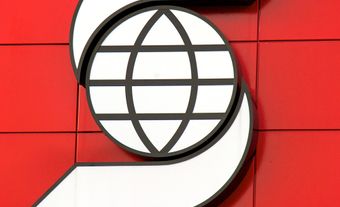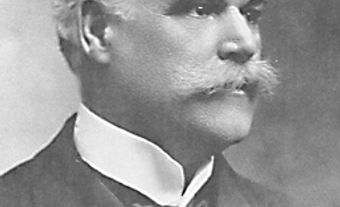Manulife Financial Corporation, based in Toronto, is Canada’s largest insurance company and one of the largest in the world. Its principal operations are located in Canada, the United States and Asia. Manulife offers life, health and income insurance protection, as well as annuities and wealth and asset management. It was founded in 1887 as Manufacturers Life Insurance Company Inc. Canada’s first prime minister, Sir John A. MacDonald, was also the company’s first president. Manulife is a public company that trades on the Toronto, New York and Philippine stock exchanges under the symbol MFC and on the Stock Exchange of Hong Kong as 945. In 2018, Manulife registered $39 billion in revenue and $4.8 billion in profit and held $1.1 trillion in assets. The company employs more than 34,000 people, who serve nearly 28 million customers.

Formation of the Company
Manulife was incorporated by an Act of Parliament as “The Manufacturers Life Insurance Company,” on 23 June 1887. Included on its list of business and political supporters was Canada’s prime minister, Sir John A. Macdonald, who was the company’s first president. Prior to his re-election in 1878, Macdonald’s Conservative Party had campaigned on a platform of creating national tariffs on many imported goods, to protect Canadian businesses (see National Policy). The word Manufacturers came from this platform, and many of the initial shareholders and directors of the company were themselves manufacturers.
The success of the new company was immediate, due in large part to the work of its first managing director, J.B. Carlile. Carlile established effective relationships with independent sales agencies in Ontario, Quebec, Nova Scotia and Manitoba. By the time of the first annual meeting on 17 January 1888 (6 months after its incorporation), the company had sold 915 policies for a total of $2.5 million in insurance coverage, earning the press’s nickname “The young Canadian Giant.” By comparison, it had taken the company’s competitor, Canada Life, nine years to sell $3 million worth of policies.
When Sir John A. Macdonald died, in 1891, the presidency of the company was assumed by George Gooderham (grandson of William Gooderham). The Gooderham family eventually became the largest shareholders in the company. In addition to growing the company’s Canadian business, Gooderham also set about growing the company internationally. A Bermuda agency was established in 1893, followed by British West Indies, Jamaica and Trinidad (1894), China (1897), Japan (1898), several other Asian countries (1899), London (1903) and Detroit (1903). This international growth continued and was tremendously successful — by 1932, 50 per cent of the company’s business was outside Canada; insurance coverage totalled $542,000,000 in 35 countries around the world.
The Early 1900s

As Manufacturers Life expanded internationally, their Canadian growth remained strong. In 1901, Gooderham built on this progress by amalgamating Manufacturers Life with the Temperance and General Life Assurance Company. This union was encouraged by several businessmen who were shareholders in both companies and believed that economies of scale would increase their combined profits. The combined company retained the name Manufacturers Life. At the time, it was the third largest life insurance company in Canada.
The First World War slowed the company’s growth, as it did for all businesses. Postwar, growth was rapid, to the extent that the company needed to build new office space. In 1925, after a construction period of more than a year, Manufacturers Life moved its headquarters in Toronto from the Dominion Bank Building (on the southwest corner of Yonge and King Streets) to Bloor Street — a location it continues to occupy today.
The Great Depression and the Second World War that followed caused a dramatic slowdown in the growth of Manufacturers Life; however, the fact that proceeds from new business exceeded insurance claims meant that the company remained healthy. This demonstrated the company’s resiliency and stability to the general public, who grew to greatly admire the insurance industry as a result.
Mid-1900s
Post-war recovery was quick and successful. In 1956, however, the Gooderham family announced its intention to sell its 45 per cent stake in Manufacturers Life. This raised concern among both management and the general public that the company could be sold to American interests. In response, the federal government quickly passed legislation allowing insurance companies to convert from being owned by public shareholders to being owned by its policyholders, a process known as mutualization. Now, if someone wanted to take over the business, they would have to purchase all the insurance policies issued by the company — an unlikely scenario given that few would be interested in selling their policies and equally few would be interested in buying them. A vote at a special shareholders’ meeting allowed Manufacturers Life to buy up its own shares, including those of the Gooderham family, and to convert to a mutual insurance company (a process that was finally completed in 1968).
The business continued to grow; insurance coverage surpassed the $3 billion mark in 1959 and Manufacturers Life reached $1 billion in assets in 1961. In 1968, the company had a second consecutive year with over $1 billion in new business; it had taken until 1949 to achieve $1 billion in business, sixty years after the company’s founding.
In 1972, there came a turning point for the company with the ascension of long-time employee Sydney Jackson to the post of president and chief executive officer. Under his leadership, the company adopted a less risk-averse business approach that led to increased levels of sales and innovation. In 1984, Manufacturers Life was successful in its acquisition of the Dominion Life Assurance Company, the 11th largest life insurance company in Canada, with $1.5 billion in assets. This transaction made Manufacturers Life the largest Canadian life insurer with assets rising from $2 billion in 1972 to $16.4 billion in 1985.
During this time, Manufacturers Life attempted to diversify into other financial areas. In 1985, the company increased its small ownership stake in Canada Trust to 30 per cent by purchasing London Life’s shares and those of Canadian General Investments. Canada Trust was not pleased with the prospect of Manufacturers Life gaining control. Another suitor, Genstar Financial Corp., successfully petitioned the Ontario Supreme Court to block any further ownership increases, on the basis that federal law prohibited life insurance companies from taking a controlling interest in businesses outside their domain. Unprepared to fight for further ownership, Manufacturers sold its position in Canada Trust to Genstar.
1990s – Early 2000s: Name Changes to Manulife
As Manufacturers Life worked to diversify its business, it decided to change its name to better represent a wider range of products and services. In 1990, the name was changed to Manulife Financial.
In 1993, Manulife made a brief foray into the banking industry when it acquired and combined the Regional Trust Company, Cabot Trust, and Huronia Trust to form Manulife Bank of Canada. However, it quickly exited the branch banking sector when it sold the physical branches of Manulife Bank to Laurentian Bank in 1994.
In 1996, the North American Life Assurance Company amalgamated with Manulife Financial when North American ran into financial trouble with its real estate portfolio. With this amalgamation, Manulife acquired ownership of mutual funds company, Elliot & Page Limited, and entered into the mutual fund business, renaming the new subsidiary Manulife Financial Asset Management Limited. Manulife attempted to bolster this new asset management subsidiary, in 1996, by making a bid for the independent mutual fund firm Altamira Management Ltd. of Toronto — Manulife already owned 30.5 per cent of Altamira as a founding shareholder in the company. Looking for a higher offer, Altamira got Toronto-Dominion Bank to put in a competing bid, but the bank eventually backed out. The hostile transaction by Manulife became very heated, and eventually Altamira convinced Boston-based TA Associates to place a higher competing bid in 1997. Manulife happily agreed to sell its holdings in Altamira to TA for a gain of $253 million. Eventually, Manulife bolstered its asset management group by purchasing AIC Ltd.’s group of mutual funds in 2009, after acquiring AIC’s independent dealer network, Berkshire Group, in 2007. In 2012, it acquired the Winnipeg-based financial planning agency Wellington West Financial Services.
To maintain an acceptable growth rate for the company, Manulife realized it would need to have better access to capital markets. Management thus decided to de-mutualize the company, to again have it owned by public shareholders rather than its policyholders. When it went public in 1999, all existing policyholders received shares valued at $18 each and the transaction, valued at $2.5 billion, was the largest initial public offering in Canadian history.
As a public company, Manulife could now be more aggressive in growing, by acquiring other insurance companies. The company made a major foray into Japan when it purchased Daihyaku Mutual Life Insurance, in 2000, for $1 billion — the largest transaction in history by a Canadian firm in Japan. That same year, it bought the Canadian life insurance operation of the UK’s Commercial Union Life, and in 2002 Manulife acquired the Swiss-based Zurich Life Insurance Company of Canada.
In 2002, the smallest of Canada’s five large chartered banks, the Canadian Imperial Bank of Commerce, tried to grow by talking with Manulife Financial about merging the two companies. These discussions did not go far, however, based on the fear that the federal government would reject the proposal because it did not want banks merging with insurance companies.
As an alternative, in 2003 Manulife made a hostile bid for its competitor Canada Life Assurance Company, which had also de-mutualized and was a public company. In rejecting this offer, Canada Life negotiated its sale to Great-West Life Assurance Company (part of financier Paul Desmarais’ Power Financial Corporation empire) with a transaction value of $7.3 billion.
Still determined to grow, Manulife announced, on 28 September 2003, its plans to merge with US insurance company John Hancock Financial Services, located in Boston. This was a $15 billion transaction which, when it closed in April 2004, created the fifth largest life insurance company worldwide, the second largest in the US, and the largest such company in Canada. The global headquarters of the new company remained in Toronto, and the combined entity kept the Manulife Financial name while retaining the John Hancock brand in the US.
Recent History

The 2008 global financial crisis was a particularly challenging time for Canadian insurance companies. To resolve the crisis situation, global monetary authorities significantly increased the supply of money and lowered interest rates. For life insurance companies who had sold products with guaranteed payouts, this meant they had trouble matching their committed higher payouts with the low-income yields that they earned on their investments. For its fourth quarter in 2008, Manulife Financial reported its first quarterly loss since going public in 1999 — $1.9 billion. The loss was mainly due to the mix of insurance and annuity products in its John Hancock subsidiary. To bolster its capital reserves, Manulife undertook a $3 billion bank loan from a consortium of Canada’s six largest banks. It also announced, in August 2009, that for the first time in its history, it would have to reduce its dividend to shareholders in order to better manage its cash flow.
The challenges continued as the world struggled to overcome the financial crisis, as interest rates remained low and as stock prices declined. Investors in Manulife were shocked when another record loss, of $2.4 billion, was announced for the second quarter of 2010.
Over the next few years, Manulife slowly recovered from this challenge. By 2014, it had recovered enough to make a successful $4 billion offer to purchase the Canadian operations of Edinburgh-based Standard Life Insurance Company; that included a $2.1 billion public stock offering to finance the purchase. In 1978, Standard Life, whose Canadian operations were based in Montreal, had agreed to a takeover by Manufacturers Life, based on its nervousness over the nationalist policies of the Quebec government at the time. The federal government agreed to that acquisition, but the transaction fell apart when Edinburgh insisted on repatriating the Canadian division’s $200 million surplus capital position. The successful 2014 acquisition of Standard Life gave a much stronger Quebec presence for Manulife Financial.
In 2017, Manulife faced public scrutiny after it was identified as the financial institution charged a $1.2 million fine, the year before, by FINTRAC, Canada’s anti-money laundering and anti-terrorist funding watchdog. The fine was for assisting a Winnipeg-based felon and pharmacist in selling counterfeit medication to Americans over the internet.

 Share on Facebook
Share on Facebook Share on X
Share on X Share by Email
Share by Email Share on Google Classroom
Share on Google Classroom


